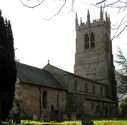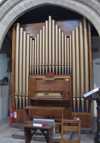 Rolleston Rolleston
Holy Trinity
Organ
The firm of Cousans was founded in 1877 by James Cousans, who trained with Harston of Newark and Thomas Nicholson of Lincoln. The firm flourished during the 1880s, building many instruments throughout Lincolnshire and the surrounding counties, and looking after the Willis instrument at Lincoln Cathedral from the time of its building in 1898. The firm also provided a temporary instrument during the time the Willis organ was constructed. That, however, was not their first organ for the Cathedral – the instrument now at Rolleston was built for the Cathedral Song School, at the behest of Dr. G.J. Bennet who was appointed Organist and Master of the Choristers in 1895. It cost £181-10-0.
 The organ from The organ from
HMP Nottingham |
 The organ The organ
from 1895 |
The organ came to Rolleston in 1933, at which point certain tonal changes were undertaken. The Great Dulciana was replaced (or rather transposed) to 16ft pitch. The basses form the treble case-return.
The case was also of 1933 vintage.
The Great was originally only of three stops – the Open Diapason was added on a clamp (or rather moved onto the clamp from another slide).
Poor quality work was carried out on the organ over an unreasonably extended period in 2005, but it was made to work by Christmas that year. Immediately afterwards the organist commented that the organ was in a worse state than it had been before the work had been carried out. Unfortunately the organ suffered rainwater ingress in January 2006 which was not covered by the insurance policy in force at that time.
Several specialists looked at the organ.
The 2005 work included relocating the 15th bases in an accessible position behind the swell box, cleaning the woodwork of the console, retune and regulate, and paint the front pipes. This work was not completed.
The water that entered the organ caused some damage, which rendered one stop ineffective, probably from debris causing it to stick, and affecting the leather pads which cause air to leak into two ranks of pipes which had to be taken out of action.
The Diocesan Organ advisor, Mr Paul Hale, felt that the work cleaning the pipes was not thoroughly done. He also noted that there were many little jobs that ought to have been done while the organ was stripped down, that could have been done at minimal cost, such as provide new springs to the keys.
Jonathon Wallace of Henry Groves and Son felt much the same, and said that the instrument is in need of a thorough overhaul. As an alternative, he suggested that we might scrap the existing organ and replace it with another Cousans organ from the Chapel at HM Prison, Nottingham which was being demolished. The organ would fit into the existing site of the organ and the casework of the current organ would be used around the prison organ, which had little. The organ is a single manual instrument, and would fill the church with sound entirely satisfactorily. He felt that the organ was not worth saving at any cost. Our then organist, Simon Freeman, played the organ and liked it.
Christopher Gray of Midland Organ took a much more radical approach, and suggested (like Jonathan Groves) restoring the organ fully. Tuning access needs to be improved, particularly to the Swell, which can only be accessed through the Great, with some difficulty. He proposed creating tuning access from the Bass and Treble ends of the box in addition. At some stage, the bass chest of the Swell Fifteenth had been removed, and this lay disconnected (along with the pipework, in a pile) on the floor of the organ. If it was not possible to replant the slide (a former Salicional slide of Tenor-C [44note] compass), then this chest must be reinstated within the swellbox to allow this rank to be under expression in its entirety. He liked the instrument, and felt that it would be a better option than bringing in the prison organ. Being a two manual organ, he felt that it would be more attractive to organists, particularly young ones, to make them want to come and play it.
The estimates for fully restoring the instrument were £500 + VAT and £14,995 + VAT, whereas replace the organ with the chapel organ would cost some £3,500 + VAT
Further discussion with the Diocesan Organ advisor resulted in a decision to replace the organ with the prison organ, which was completed in January 2007.
The prison chapel had been continuously heated, but in the damper environment of the church the octave doubler would not function, and so was disconnected.
|